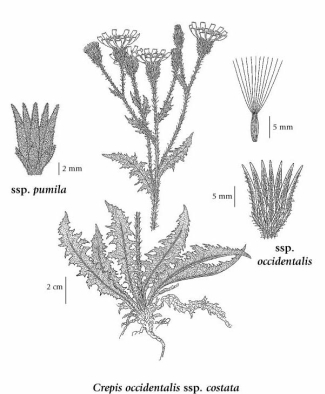Click on the image below to view an
expanded illustration for this species.

|
General:
Perennial herb from a taproot and stem-base; stems erect, 1-3, densely and closely grey-short woolly-hairy, or nearly glabrous in age, often glandular-stiff-hairy above, sometimes with black glandular bristles above, 5-40 cm tall.
Leaves:
Basal leaves long-stalked, toothed, with the teeth pointing backwards, or deeply pinnately cut with lanceolate or linear toothed lobes, these entire, abruptly sharp-pointed or with long-pointed tips, mostly 1-3.5 dm long, the blades grey-short woolly-hairy, or nearly glabrous in age; lower stem leaves similar to the basal leaves, becoming reduced, linear and entire upwards.
Flowers:
Heads with strap-shaped flowers, 2-25 in a flat-topped inflorescence; involucres 11-19 mm tall, cylindric or bell-shaped; involucral bracts grey, short woolly-hairy with or without gland-tipped hairs, the longest outer ones usually less than 1/2 as long as the inner, triangular or egg-shaped, abruptly sharp-pointed, rarely linear, the inner ones lanceolate, abruptly sharp-pointed or with long-pointed tips with membranous margins; ray flowers yellow, 16-19 mm long.
Fruits:
Achenes, light to dark brown, 6-10 mm long, spindle-shaped, 10- to 18-ribbed, only slightly tapering to a slender tip; pappus white to yellowish-white, of copious, soft, hairlike bristles.
Notes:
Three subspecies, sometimes difficult to separate, occur in BC.
1. Involucres with at least some gland-tipped hairs.
2. Largest heads 18- to 30-flowered, with 10-13 inner involucral bracts.................. ssp. occidentalis
2. Largest heads 12- to 14-flowered, with 8-9 inner involucral bracts....................... ssp. costata (A. Gray) Babc. & Stebb.
1. Involucres without gland-tipped hairs..................... ssp. pumila (Rydb.) Babc. & Stebb.
Source: The Illustrated Flora of British Columbia
|
